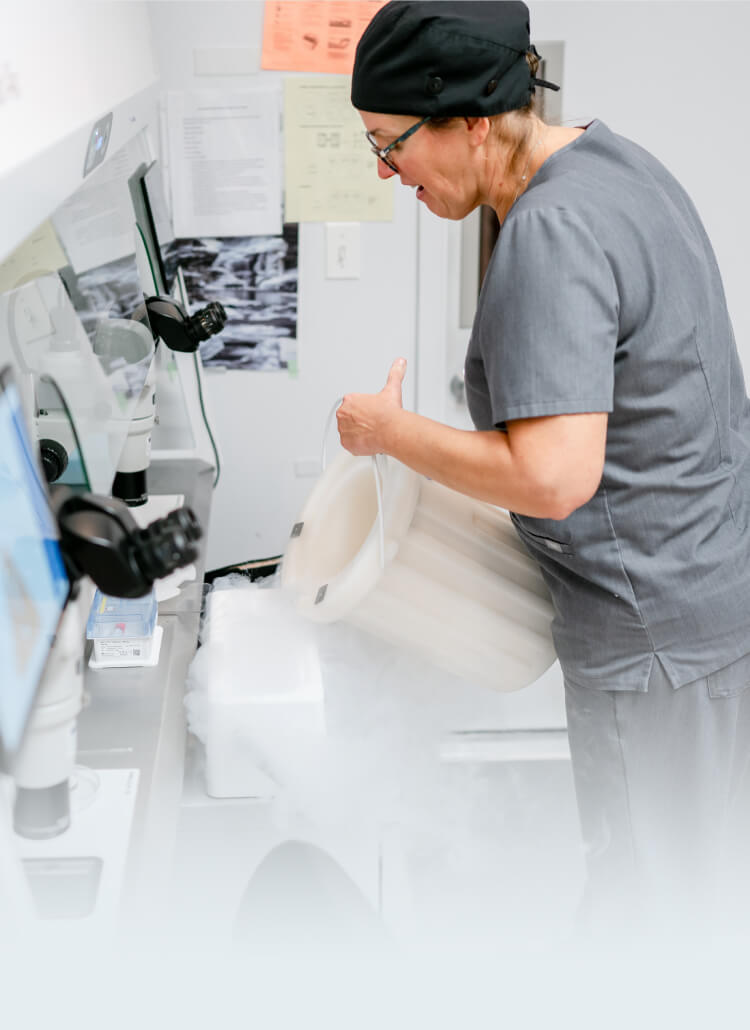Understanding Embryo Cryopreservation After IVF
Cryopreservation is the process of freezing tissue or cells to preserve them for the future. In fertility care, cryopreservation is used to freeze and store eggs and sperm, as well as embryos created through an in vitro fertilization (IVF) cycle. At the Advanced Fertility Center of Chicago, our labs achieve exceptional cryopreservation rates by using an advanced ultra-rapid freezing technique known as vitrification.
Factors Influencing Availability of Extra Embryos
The availability of extra embryos for freezing after an IVF cycle is influenced by a variety of factors, each playing a crucial role in determining the number and quality of embryos that can be preserved for future use:
-
Egg Quality: The quality of eggs retrieved during the IVF cycle is a key determinant. Higher-quality eggs are more likely to fertilize and develop into viable embryos.
-
Number of Eggs Retrieved: The more eggs retrieved, the higher the chances of having extra embryos. However, not all eggs will fertilize or develop into healthy embryos.
-
Embryo Quality: Only embryos that reach a certain developmental stage (typically the blastocyst stage) and exhibit good morphology and cell division rates are considered suitable for freezing.
-
Stimulation Protocols: Different ovarian stimulation protocols can impact the number of eggs retrieved and the quality of the resulting embryos.
-
Patient’s Health and Fertility History: Factors like previous fertility treatments, underlying health conditions, and the cause of infertility can influence the success of the IVF cycle and the number of embryos available for freezing.
Percentage of IVF Patients with Extra Embryos for Freezing
The percentage of patients who have extra embryos available for freezing after an IVF cycle can vary widely based on several factors, including the patient's age, the quality of the embryos, the number of eggs retrieved, and the specific protocols used by the fertility clinic. Of these factors, age plays the biggest role:
-
Patients under 35 years: For younger women, particularly those under 35 years old, it is common to retrieve a higher number of eggs, leading to more embryos. About 40-60% of these patients may have extra embryos of good quality available for freezing after the initial transfer.
-
Patients aged 35-40: In this age group, the percentage of patients with extra embryos available for freezing typically decreases to about 30-40%. The quality of eggs and embryos tends to decline with age, reducing the number of viable embryos suitable for freezing.
- Patients over 40: For women over 40, the likelihood of having extra embryos available for freezing drops further, with approximately 10-20% having surplus embryos. The reduced egg quality and quantity at this age significantly impact the number of embryos that can be successfully frozen.
Understanding Vitrification
Vitrification is a rapid freezing technique used in cryopreservation, particularly for embryo freezing in IVF treatments. Unlike traditional slow-freezing methods, vitrification involves quickly cooling embryos to an ultra-low temperature, transforming them into a glass-like solid state without forming ice crystals. Before this process, cryoprotectants are added to the embryos to protect them from potential damage by preventing ice formation. This combination of cryoprotectants and vitrification minimizes the risk of cellular damage, significantly increasing the survival rate of embryos during thawing and leading to improved outcomes in subsequent IVF cycles.
Advanced Fertility Center of Chicago started vitrification of blastocysts in our IVF lab in early 2008 and have seen excellent post-thaw embryo survival and substantially higher pregnancy rates after frozen transfer procedures.
Choose AFCC for Embryo Freezing in Chicago
AFCC offers peace of mind by providing the most advanced embryo cryopreservation techniques and using the most state-of-the-art technology available. Ready to take the next step? Our team is here to answer all your questions and concerns so that you can move forward with confidence. Contact Advanced Fertility Center of Chicago today for more information about embryo freezing or to schedule a consultation at one of our fertility clinics in Chicago, Downers Grove, Arlington Heights or Gurnee, IL.



